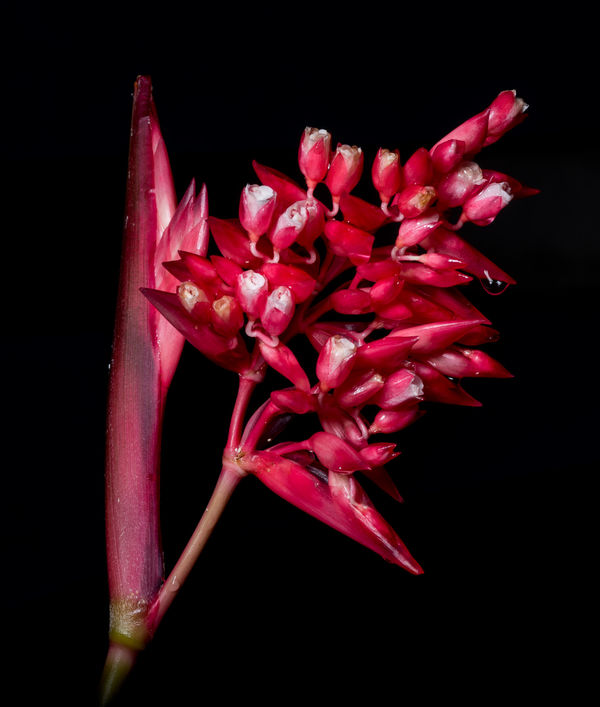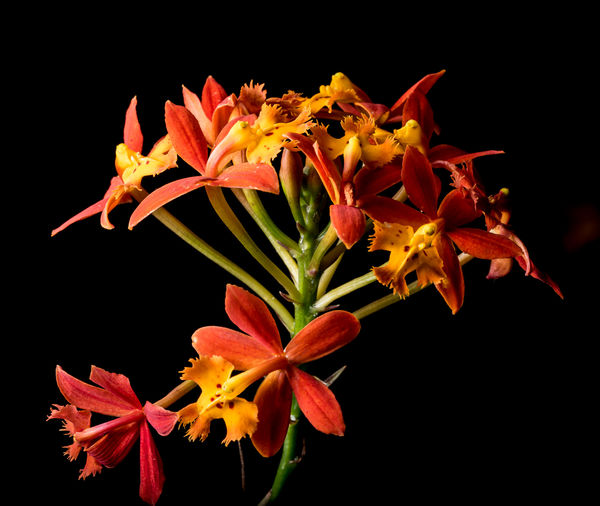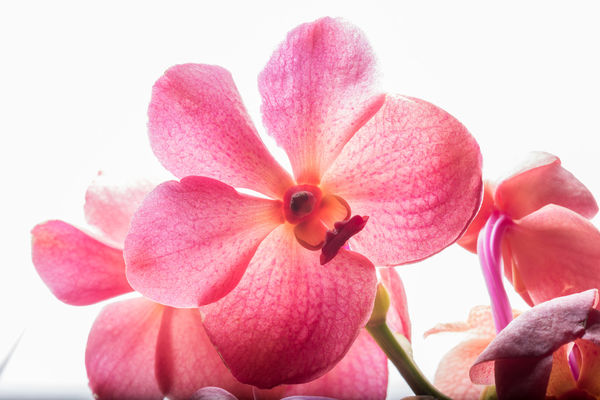Manual Flash Question
Mar 9, 2018 09:49:23 #
I just got a cheep flash and Nikon sc-28 cord for off camera flash. I want to shoot close up flower pictures hand held. I watched a few videos and did some reading, but still don't fully understand how the flash a low power of say 1/64th freeze the flower movement and provides enough light at say f16 for depth of field. Is it because the flash is close to the lens? How does a shutter speed of 250 of a second affect the picture if any? I will have a small soft box on the flash to make it softer light.
Mar 9, 2018 10:02:35 #
Be careful of the trigger voltage if this is an older flash unit. What camera do you have and what is the sync speed?. If it's low, you may be able to do high speed sync with the unit. What brand and model number is the flash? Flash to subject distance determines exposure, not flash to the lens.
gary8803 wrote:
I just got a cheep flash and Nikon sc-28 cord for ... (show quote)
Mar 9, 2018 10:27:14 #
gary8803 wrote:
I watched a few videos and did some reading, but still don't fully understand how the flash a low power of say 1/64th freeze the flower movement and provides enough light at say f16 for depth of field. Is it because the flash is close to the lens?
Light generally follows an inverse square law relationship. Something twice (2x) as far from the light source will receive 1/4 the amount of light on its surface. Of course, since the flash is not a point source of light and is directional, this relationship is not exact, but gives you the general idea. In addition, a flash is emitted for a very brief period of time, usually freezing motion.
Mar 9, 2018 10:30:32 #
By freezing motion, it negates the need for stabilization either in the lens or body....
Mar 9, 2018 10:39:46 #
photoman022
Loc: Manchester CT USA
First, a shutter speed of 1/250: Check the shutter sync speed of your camera. They usually max out at 1/200 (I've read of some cameras with a max sync speed of 1/160). If you go faster than the sync speed, a black band will form across your photo and it will get larger the faster you go over the sync speed.
Second, a flash at 1/64th power may not provide enough light at f/16. The shutter speed affects ambient light; you aperture (f/stop) affects the amount of flash you receive. If you shoot at f/16 you will probably have to increase the flash power. You will only know this as you experiment, but, after a while, you will know what settings work best. If you want to shoot at 1/64th power, you can open up the aperture to let in the appropriate light from the flash (larger apertures [f/4, for example) mean smaller depths of field, smaller apertures [f/16] means larger depths of field). The point is, the depth of field you want will also affect the choice you make. The distance of the flash from the subject also affects the amount of light. If your flash is really up close to the flower, then 1/64 power at f/16 may work -- or it may not. It depends on the amount of light the flash puts out.
The section is becoming confusing because of the way light works. I guess the easy way to explain it is start with your flash at 1/64 power and increase the flash power until you get the photo you want at the f/stop you want. The shutter speed will only affect your background light and will have no impact upon the flash because the flash's lighting duration is only a fraction of that of the shutter speed.
Second, a flash at 1/64th power may not provide enough light at f/16. The shutter speed affects ambient light; you aperture (f/stop) affects the amount of flash you receive. If you shoot at f/16 you will probably have to increase the flash power. You will only know this as you experiment, but, after a while, you will know what settings work best. If you want to shoot at 1/64th power, you can open up the aperture to let in the appropriate light from the flash (larger apertures [f/4, for example) mean smaller depths of field, smaller apertures [f/16] means larger depths of field). The point is, the depth of field you want will also affect the choice you make. The distance of the flash from the subject also affects the amount of light. If your flash is really up close to the flower, then 1/64 power at f/16 may work -- or it may not. It depends on the amount of light the flash puts out.
The section is becoming confusing because of the way light works. I guess the easy way to explain it is start with your flash at 1/64 power and increase the flash power until you get the photo you want at the f/stop you want. The shutter speed will only affect your background light and will have no impact upon the flash because the flash's lighting duration is only a fraction of that of the shutter speed.
Mar 9, 2018 10:50:49 #
lsimpkins wrote:
Light generally follows an inverse square law relationship. Something twice (2x) as far from the light source will receive 1/4 the amount of light on its surface. Of course, since the flash is not a point source of light and is directional, this relationship is not exact, but gives you the general idea. In addition, a flash is emitted for a very brief period of time, usually freezing motion.
Actually, the flash being a point source, or not, doesn't matter for the inverse square relationship. Since the light from the flash will come from the same distance (or close enough not to make a difference you can measure) to the subject the inverse square formula will be exact. So, you are more correct than you thought.
Mar 9, 2018 11:34:37 #
photoman022 wrote:
First, a shutter speed of 1/250: Check the shutte... (show quote)
Well said. I would add that f16 DOF is wasted with a flash. The portion of the image with perfect exposure is relatively small. A few feet past that and the subjects are underexposed. Closer and they are overexposed. Using a larger aperture with a flash will fit closer with the amount of sufficient exposure.
Also, I would suggest that if the flash and camera don't synchronize then experiment. Take notes of camera and flash settings and the distances, angles, and use of the softbox and any reflector card. Referring to the notes will help understand the characteristics of the setup.
Mar 9, 2018 11:42:24 #
Remember, that shutter speed controls how much ambient light hits your sensor, aperture controls how much light from the flash hits your sensor.
F-16 will reduce how much light you are getting when using flash. Try F-8, you'll still get a lot of depth of field unless you are trying Macro, in that case, you will get shallow depth of field no matter what you do unless you try focus stacking.
As for freezing motion. If you are using the flash to light the subject, and not the ambient light... the 1/10,000 (ish) of a second that your flash is firing, will freeze any action. Unless your flower moves faster than the speed of light??? The more ambient light you let in (slower shutter speed) the more motion you may notice, because you aren't relying on the flash to light your subject, just more to "highlight" it.
F-16 will reduce how much light you are getting when using flash. Try F-8, you'll still get a lot of depth of field unless you are trying Macro, in that case, you will get shallow depth of field no matter what you do unless you try focus stacking.
As for freezing motion. If you are using the flash to light the subject, and not the ambient light... the 1/10,000 (ish) of a second that your flash is firing, will freeze any action. Unless your flower moves faster than the speed of light??? The more ambient light you let in (slower shutter speed) the more motion you may notice, because you aren't relying on the flash to light your subject, just more to "highlight" it.
Mar 9, 2018 12:05:49 #
What typically happens when you use too slow of a shutter speed for the light conditions, is that you will get two images. One from the flash & another from the ambient light. Don't ask me how I know...LOL
bkyser wrote:
Remember, that shutter speed controls how much amb... (show quote)
Mar 9, 2018 12:29:57 #
gary8803 wrote:
I just got a cheep flash and Nikon sc-28 cord for ... (show quote)
Funny I just took a series of orchids and other flowers using your intended approach last Friday.
A couple of pointers:
A power setting of 1/64 may be too low, causing you to boost your ISO a bit more than you'd want.
Lower power settings = shorter duration flash bursts - at 1/64 power your burst could be 1/20,000 or shorter.
A faster shutter speed will minimize ambient light.
If you hold the light to the side (right angle to the line of sight of the camera) you will avoid illuminating the background.
Forget the cord - use a cheap set of wireless triggers. More flexibility. I use an old Yongnuo RF602 receiver and the corresponding FR-602TX transmitter. The current model is the RF605 transceiver, and they cost $34 for a pair. Using a wireless trigger usually gets around the sync voltage issue.
The shortest sync speed on most Nikons is 1/250 sec, some older or electronic shutter cameras will sync at a shorter shutter speed. Canons usually cannot sync any shorter than 1/200 without the black band at the edge of the frame.
For this series I used 1/8 to 1/4 power on the speed light (an old Auto Sunpak 444D set to manual), D810, Sigma 150 F2.8 Macro, ISO 100, 1/250 and F22, with the flash held about 8-12 inches away, but I use a large bounce surface, similar to a Better Bounce Card Studio. An even better solution is a Rogue Flashbender 2 XL - the silver reflector will give you more texture detail, the white will provide a softer overall look.
These were not masked, but were processed to darken the background using the sliders in Lightroom - shadow, black, highlight, white, contrast exposure along with a little clarity. I was by myself so it was a little hard to maintain focus the way I wanted to, with the left had outstretched as far as possible and the right hand holding and focusing the camera, but it is possible.
The last image was a backlit shot where I was able to get the flash and bounce card behind the flower.
Mar 9, 2018 12:43:30 #
Joe Blow wrote:
Well said. I would add that f16 DOF is wasted wi... (show quote)
That is the voice of inexperience. I use F16 and F22 in exactly these situations. See my post above.
Mar 9, 2018 12:45:21 #
photoman022 wrote:
First, a shutter speed of 1/250: Check the shutte... (show quote)
He can also increase the ISO to use lower power on the flash. But 1/64 is not necessary.
Mar 9, 2018 13:40:39 #
lautenk2 wrote:
Actually, the flash being a point source, or not, doesn't matter for the inverse square relationship. Since the light from the flash will come from the same distance (or close enough not to make a difference you can measure) to the subject the inverse square formula will be exact. So, you are more correct than you thought.
Sorry, but can you repeat that in English please!
Mar 9, 2018 15:52:30 #
speters wrote:
Sorry, but can you repeat that in English please!
It is in English. And it makes perfect sense.
You will need to re-read it until it makes sense. This should clear things up

https://en.wikipedia.org/wiki/Inverse-square_law
Mar 9, 2018 17:50:56 #
Gene51 wrote:
Nothing in that statement does makes any sense whatsoever! And I do not need to read anything of the inverse -square law, I know all about it!It is in English. And it makes perfect sense.
You will need to re-read it until it makes sense. This should clear things up
https://en.wikipedia.org/wiki/Inverse-square_law
You will need to re-read it until it makes sense. This should clear things up

https://en.wikipedia.org/wiki/Inverse-square_law
If you want to reply, then register here. Registration is free and your account is created instantly, so you can post right away.









